August Newsletter 2014
 Are you planning a road trip during the month of August? Your
membership at the La Madrona Athletic Club gives you access to 6
additional clubs (5 of which are in our beautiful state of California).
You and your family may go to each of our sister clubs up to 2 times in
a calendar month for free! Here is a list of our sister clubs and
their locations.
Are you planning a road trip during the month of August? Your
membership at the La Madrona Athletic Club gives you access to 6
additional clubs (5 of which are in our beautiful state of California).
You and your family may go to each of our sister clubs up to 2 times in
a calendar month for free! Here is a list of our sister clubs and
their locations.
Avila Bay Athletic Club and Spa~ 6699 Bay Laurel Drive, Avila Beach, CA 805-595-7600 Website: avilabayclub.com
Avila Bay Athletic Club and Spa is a full-service tennis and swim club which incorporates a 'state of the art' fitness facility. Our San Luis Obispo area gym is located on four acres of tropical grounds in the heart of the Avila Valley on California's Central Coast.
Ojai Valley Athletic Club~ 409 South Fox Street, Ojai, CA 805-646-7213 Website: ovac.caclubs.com
Located in the scenic Ojai Valley in Ventura County, California, Ojai Valley Athletic Club features a beautiful five acre tennis, swim and fitness facility. Our caring staff welcomes couples, families, singles and seniors alike to our club.
Westlake Athletic Club~ 32250 Triunfo Canyon Rd, Westlake Village, CA 818-889-6164 Website: wac.caclubs.com
Conejo Valley’s premier tennis, aquatic, and fitness facility located on 6 beautiful acres in Westlake Village, near Thousand Oaks. Our gym offers an array of programs and activities for everyone. Enjoy a match or workout in a comfortable, friendly and relaxed environment that is designed to put you at ease the moment you walk through the doors of one of the premier Thousand Oaks area gyms. Your wellness is our objective and we strive to assist you in realizing lifelong benefits that result from a fit and healthy lifestyle.
Paso Robles Sports Club 2975 Union Road Paso Robles, CA 93446 805-239-7397 Website: prsc.caclubs.com
The Paso Robles Sports Club features a beautiful swimming complex, eight exceptional tennis courts, fitness facility, Café, and second level fitness studio with stunning panoramic views.
The Hills~ 2400 Manzanita Drive Oakland, CA 510-339-0234 Website: hills.caclubs.com
Enjoy amazing scenic views of Mt. Diablo from our fully equipped fitness facility; the best Oakland swimming complex, tennis courts and pilates studio near Berkeley. The Hills, located in Oakland, CA is truly a hidden gem for its members and guests.
Ogden Athletic Club~ 1221 East 5800 South, South Ogden, Utah 801-479-6500 Website: oac.caclubs.com
OAC is a premier full-service, private health club in South Ogden. OAC believes in the power of living a healthy life and strive to be far more than just a gym – they are a community filled with passionately health-minded members and staff. OAC tailors our approach to the needs of each individual, family and our greater community and in doing so create meaningful and long-lasting relationships that span generations.
Take advantage of the opportunity to travel our beautiful west coast and enjoy your clubs away from your club home.
Parents Night Out
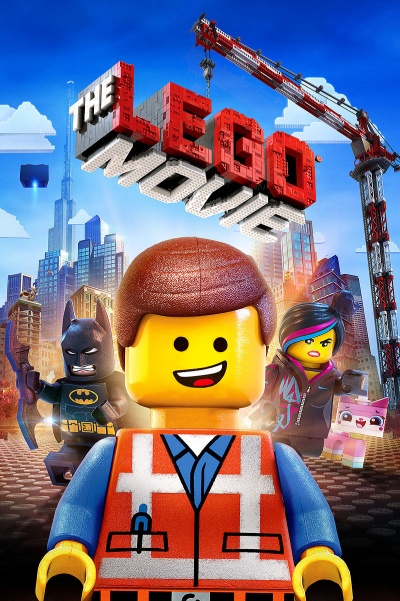 Friday, August 22nd
Friday, August 22nd
5pm-7:30pm
Drop your kids off for a fun filled night of pizza, popcorn, crafts, and treats!
Featured Film: Lego Movie (rated PG)
Cost: $15 per child, $12 for additional siblings
6 years and older
Sign up in the Clubhouse. Limited space available.
Updates from the Tennis Department
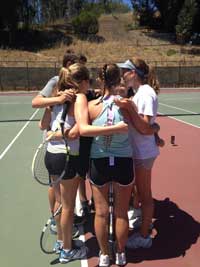 La Ma junior USTA team going to Fresno Summer Sectionals! Team members include Desi Rakela, Gabe Ares, Brendan Dietrich, Maddie McCarthy, Isabella Dyc-O Neal, Phoebe Scholar, Silas Emerson, Alex Strehlke, Nolan Heath and Lily Stricker.
La Ma junior USTA team going to Fresno Summer Sectionals! Team members include Desi Rakela, Gabe Ares, Brendan Dietrich, Maddie McCarthy, Isabella Dyc-O Neal, Phoebe Scholar, Silas Emerson, Alex Strehlke, Nolan Heath and Lily Stricker.
Congrats to our Tennis Director, Judy Newman, who's tennis has really put her on the map! This year, she was chosen for the 2014 U.S. Women's 50 Cup Team, so she traveled to Florida in April to play the Senior World Championships. Her team placed 2nd only to France. In the individual competition, Judy and her teammate, Vicky Bucholtz, won the silver medal in doubles. Just this month, she played the National Grass Courts at Forest Hills, New York where she won a gold ball in doubles and bronze in singles. Judy is currently ranked #1 in doubles and # 3 in singles in the U.S.
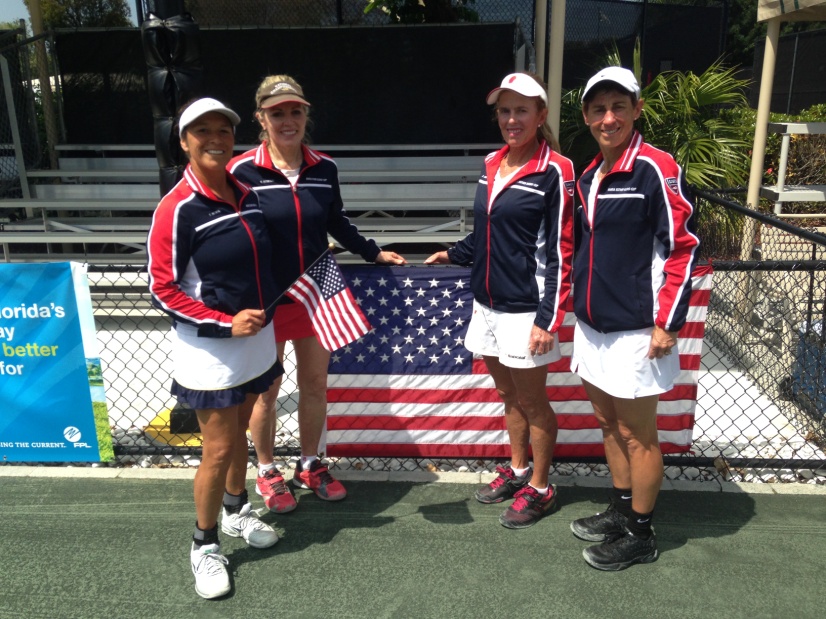
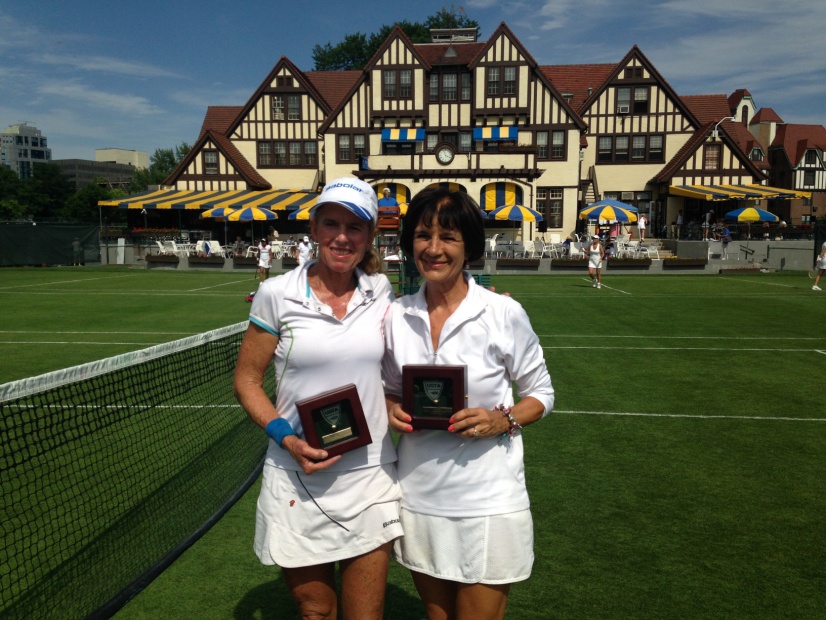
Need a racquet to borrow or have one to lend? Our demo racquets have gone missing too many times, so instead we are providing gently-used adult and junior racquets to borrow (on the "honor system") in our upper and lower ball sheds. If you have an extra racquet in good condition that you might like to donate, please bring it to us!
New Saturday Drop-In Policy: Club members who start playing on Saturday mornings before 9:00 may stay on their court until 10:00, at which time they must either join the drop-in or surrender their court if others are waiting. This will help players who need to warm-up early for a tournament or want to play their own tennis before the drop-in goes into full-swing. The drop-in is ideal for the majority of our tennis players, 3.0-4.0 level.
The USTA Adult Combo and Mixed 55 & Over Leagues are upon us! Team registration is due August 18 and teams are beginning to form. The season starts September 15. La Madrona may field mixed doubles 55+ teams in 7.0, 8.0 and 9.0 divisions, while with Combo (two doubles players of ratings 1/2 to 1 point apart), we have strong possibilities in the men's and women's combined 6.5, 7.5, 8.5 and men's 9.5. Three doubles teams are needed to play in each match, and team rosters should have 12-15 players. Matches are played on weekends and evenings. Please contact Judy right away if you would like to register a team as captain, or if you would like to play or have any questions regarding joining a team.
Pro's Video Tip of the Month: Be Selective about your Tosses! Click here to watch our tennis pro staff in action:
6 Tips for Exercising Safely in the Heat
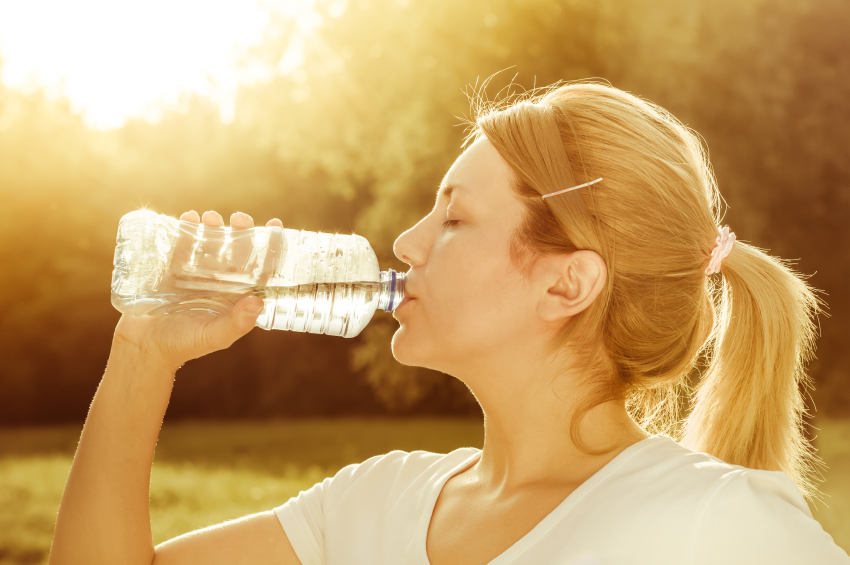 You’ve waited all winter for the sun to be shining and temperatures to rise. But by mid July, sweltering temperatures may wreak havoc on your outdoor workouts. Heat exhaustion and heat stroke are potentially serious medical conditions that can be fatal.
You’ve waited all winter for the sun to be shining and temperatures to rise. But by mid July, sweltering temperatures may wreak havoc on your outdoor workouts. Heat exhaustion and heat stroke are potentially serious medical conditions that can be fatal.
Heat exhaustion actually has two categories: water depletion and salt depletion. Water depletion symptoms include excessive thirst, weakness, headache and loss of consciousness. Salt depletion signs include nausea and vomiting, frequent muscle cramps and dizziness. However, neither of these conditions are as serious as heat stroke.
Heat exhaustion can progress to heat stroke if proper intervention is not taken. Heat stroke symptoms include all the signs of heat exhaustion but also rapid heartbeat, confusion, fainting and profuse sweating as well. It’s essential to hydrate and cool the body as quickly as possible. If you’re outside, try to find a shady or cool place, or better yet, get indoors to an air-conditioned room. Also drink plenty of fluids, avoid caffeine and alcohol and take a cool shower or bath. If you’re not recovering within 30 minutes of taking these measures, seek medical attention.
Keep in mind that other risk factors besides the heat may lead to these conditions. Age, certain health conditions and even medications may affect your workouts.
If you’re still willing to meet the heat, here are six tips for staying cool while you heat up that calorie burn.
- Early Late. It’s usually cooler in the early morning and late evening. Temperatures can be 5 to 20 degrees cooler on the average, especially in the Midwest and mountains. If you’re exercising in the dark, be sure to wear reflective clothing to be seen or wear lights if you’re riding a bike.
- Lighten Up. Dark clothing may be slimming, but wearing dark clothes can raise your body temperature if you’re out in the sun. Wear light-colored clothing to stay cooler and avoid direct sun if possible. Hiking in the woods can be cooler than in the open meadows.
- Cotton’s Rotten. Although cotton is a great fabric for its softness and strength, wearing cotton on a warm sunny day during your workout may cause blisters. The fabric holds moisture and then stretches as you move, which causes friction to the body. Wearing wicking fibers like anti-microbial wools can keep you cooler and won’t hold the stink. Staying drier will keep you cooler too. Look for DRYFIT, SWIFTWICK and other brands with moisture-wicking properties. Also keep in mind that it’s not just your feet that sweat.—armpits, thighs and even your underwear can cause heat friction blisters on those areas as well. That’s why it’s best to wear wicking fibers all over your body.
- Hydra-cise. While you exercise, be sure to hydrate before, during and after—especially in the heat. If you’re exercising for more than 90 minutes in the heat, you’ll want to replace electrolytes as well with formulated products like Gatorade. Coconut water also can help replace many needed electrolytes, but it is missing sodium, which is a key electrolyte that leaves your body when you sweat. Save money and add a pinch of salt to your water and sip every 10 to 15 minutes.
- Get Wet. It never feels like you’re sweating while you are working out in the pool so choose workouts like swimming, water aerobics classes or running in shallow water. The key is to keep a lower body temperature to avoid heat stroke. But don’t think that because you’re not sweating that you’re not working hard. Unlike your heart rate, sweat is not an indicator of intensity.
- Top it Off. Wearing a cool vented hat or visor can help reduce the heat’s effects on your outdoor workouts. Choose lightweight fabrics and light colors that reflect the light. Also be sure to keep it tight enough around your head to stay in place, but not so much that it restricts blood flow. Sunglasses are also a great idea, but choose sport-focused styles so that your nose doesn’t pay the price of a wire digging into your face.
Don’t forget that your skin is susceptible to the sun’s harmful heat rays. Wearing sunscreen is essential to exercising in the sun. There are several free apps that can help remind you to reapply protective sunscreen or have suspicious moles evaluated for skin cancer risk.
Reprinted from American Council on Exercise
Member Profile: Benjamin Colt Tarr
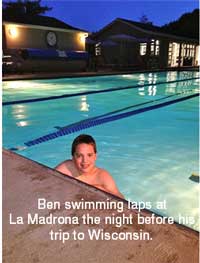 Inspiration? Motivation? Drive? These are not usually things we derive from thirteen year old boys, but they can be found in our club’s young member, Benjamin Colt Tarr. His favorite place in the world is a cabin on a lake in Wisconsin that was originally purchased by his great-great grandfather. Every two years, his family visits the lake and cabin for a little more than a week - water and the fun in and around it are the center of this trip.
Inspiration? Motivation? Drive? These are not usually things we derive from thirteen year old boys, but they can be found in our club’s young member, Benjamin Colt Tarr. His favorite place in the world is a cabin on a lake in Wisconsin that was originally purchased by his great-great grandfather. Every two years, his family visits the lake and cabin for a little more than a week - water and the fun in and around it are the center of this trip.
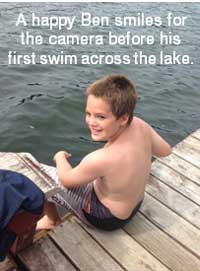 Here is where the inspiration starts. Benjamin noticed the hundred milers club in the information board by the poolhouse (Have you noticed it?). He wondered if he could swim a mile - curiosity. He got in the pool and swam eighty laps -accomplishment. Ben put his name on the board and started to mark off the miles - now he had a goal. As he continued to mark off the miles, Benjamin made connections. He realized that the lake at the family cabin was a half mile across, and he understood that he may be able to swim across the lake and back. When asked what the hardest thing about being a kid is Benjamin said, “Knowing that one day you’re going to be an adult.” Well, lucky for him, he has a grasp on one of the most difficult parts of adulthood - he has figured out a way to set goals and push himself toward them. If you see Mr. Benjamin Colt Tarr around the club, congratulate him on his endeavor this summer, and maybe jump in the pool with him to begin your own journey!
Here is where the inspiration starts. Benjamin noticed the hundred milers club in the information board by the poolhouse (Have you noticed it?). He wondered if he could swim a mile - curiosity. He got in the pool and swam eighty laps -accomplishment. Ben put his name on the board and started to mark off the miles - now he had a goal. As he continued to mark off the miles, Benjamin made connections. He realized that the lake at the family cabin was a half mile across, and he understood that he may be able to swim across the lake and back. When asked what the hardest thing about being a kid is Benjamin said, “Knowing that one day you’re going to be an adult.” Well, lucky for him, he has a grasp on one of the most difficult parts of adulthood - he has figured out a way to set goals and push himself toward them. If you see Mr. Benjamin Colt Tarr around the club, congratulate him on his endeavor this summer, and maybe jump in the pool with him to begin your own journey!
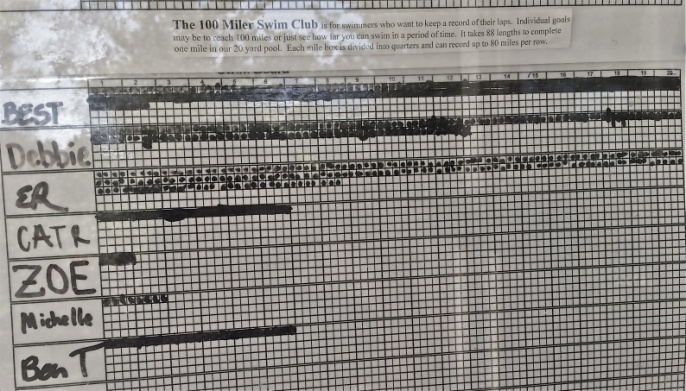
The Hundred Milers Swim Club is for swimmers who want to keep a record of their laps. Individual goals may be to reach 100 miles or just see how far you can swim in a period of time. It takes 88 lengths to swim a mile in our 20-yard pool. To get started, write your name in one of the rows and mark a box for every quarter mile (22 lengths) you swim. Each row on our miler’s swim chart has enough boxes to track 100 miles. How far can you swim before the end of the year?
Outdoor Fitness
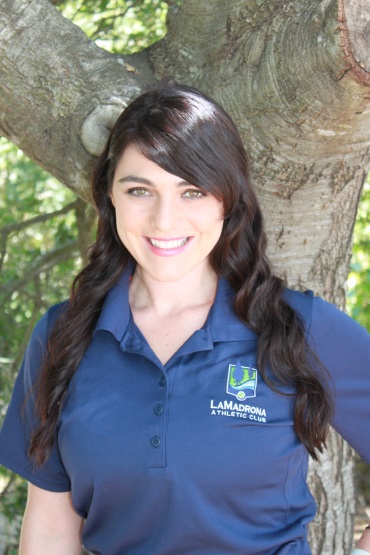
Join our Outdoor Fitness class to get a total body workout in the great outdoors. This class will combine aerobic conditioning, strength training and yoga in a positive, energizing environment. Using the different outdoor areas of the club, we will find new and different ways to challenge our bodies. Come have some fun, sweat and soak up some Vitamin D. All levels are welcome! The class is held Tuesdays at 6pm, meets in the fitness room and starts August 5th. Class included in membership.
SHANNON’S YOGA CORNER
Your Body Loves Yoga
I fell in love with yoga during the fall of 1994. After spending four grueling years studying chemistry and physics at U.C. Davis, I was in need of adventure and excitement. I flew from San Francisco to Hong Kong, and then onto Indonesia, Singapore, Malaysia, and Thailand. It just happened that my physics professor from Davis had received a temporary teaching position at the Universty of Dehli. He invited me to stay in one of the student dorms. Though I hadn’t seriously considered India as part of my adventure, it turned out to be one of the most fantastic experience of my life. India was where I first became acquainted with yoga.
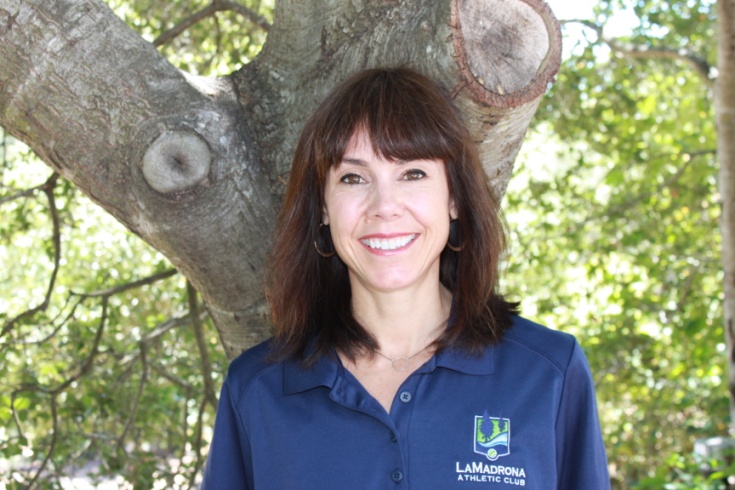 After spending some time at the University of Delhi, I set out to do a little exploring on my own. I befriended a lovely young woman who would roll out her yoga mat every morning on the grassy lawn behind our hotel. Her every ritualistic movement was one of infinite patience. In retrospect, I sense that I was completely mesmerized by her seamless stretches and supple poses. Her whole practice had a sense of ease and fluidity, as if she were moving to the sound of an inner mantra. I took what I learned back with me and started to teach yoga at my Alma mater. Yoga was a novelty for my peers during this time. It was the lull before the yoga explosion in the West. I often would get a very curious response when I invited people to my yoga class: “Huh, yoghurt?”
After spending some time at the University of Delhi, I set out to do a little exploring on my own. I befriended a lovely young woman who would roll out her yoga mat every morning on the grassy lawn behind our hotel. Her every ritualistic movement was one of infinite patience. In retrospect, I sense that I was completely mesmerized by her seamless stretches and supple poses. Her whole practice had a sense of ease and fluidity, as if she were moving to the sound of an inner mantra. I took what I learned back with me and started to teach yoga at my Alma mater. Yoga was a novelty for my peers during this time. It was the lull before the yoga explosion in the West. I often would get a very curious response when I invited people to my yoga class: “Huh, yoghurt?”
Shortly thereafter, I fell in love with my husband-to-be and moved to Los Angeles. Yoga already had a strong foothold in Venice Beach and Santa Monica. At the time, I could drop-into almost any class and for less than $20 have a front row experience with some of the best yoga instructors like Ana Forrest and Jill Miller. By then, I’d started teaching middle school science, bringing yoga into my classroom where appropriate.
Today, some nineteen years later, I am once again a full time yoga instructor, teaching the yogic arts in an environment that is clearly more receptive to this esoteric tradition. In fact, according to a recent poll by Yoga Journal, over 20.4 million Americans are practicing yoga as of 2012 (Yoga Journal, 2012). In addition, nearly 14 million Americans (6.1 % of the population), reported that a doctor or therapist had recommended yoga for various health conditions(1). Academic validation of yoga is increasing exponentially as well. Dozens of studies are underway at top medical institutions around the country—including Duke, Harvard, and the University of California at San Francisco. While research about how yoga works is still in the early stages, what is clear is that yoga is one of the most popularized and widely practiced Eastern approaches. Why? Because your body loves yoga. Here are just a few reasons why.
BENEFITS AND CLINICAL EVIDENCE
- Pain Relief: In a study conducted at UCLA with women who suffered from rheumatoid arthritis, about half of the participants who took part in a six-week Iyengar Yoga program reported major improvements in terms of pain and anxiety relief and depression.
- Healthy weight: a regular yoga practice for 60 minutes three times a week has been proven to be an effective tool for maintaining a healthy weight according to a 2013 review of seventeen clinical trials.
- Equanimity: Functional MRI screenings have shown that yoga increases activity in the left prefrontal cortex—the area of the brain that’s associated with positive moods, equanimity, and emotional resilience. As a result, yoga practitioners are better equipped to handle life’s inevitable ups and downs, and generally feel happier.
- Stress buster: Another benefit of yoga is that it induces your body’s relaxation response. The relaxation response is the opposite of the fight-or-flight response. It is your body’s innate ability to reduce stress and stress-related illnesses. Because yoga activates the body’s relaxation response, it is helpful in reducing stress-related illness, such as high blood pressure, pain, anxiety, depression, and symptoms resulting from cancer treatments. During periods of deep relaxation, the body’s basic metabolic functions drop significantly. Breathing and heart rate are slowed down; less oxygen is consumed and less carbon dioxide is produced. In short, yoga functions as form of moving meditation, which differentiates it from other physical practices, ones designed to maintain a healthy lifestyle.(2)
Nearly twenty years have passed since I taught yoga at U.C. Davis. Today, it’s not unusual to find yoga on most college campuses around the country. In fact, at least two universities offer a Master of Arts degree in Yogic Studies. In addition, yoga has found its way into hospitals, research institutions, schools, and the military.
Best of all, yoga is available at La Madrona. As club members you can now experience yoga for yourself. Join Judy Newman on Thursday evenings to practice poses that will accelerate your tennis game. Judy’s classes focus on increasing your strength, flexibility and balance. You can also book a private yoga lesson with Shannon McQuaide. Private lessons offer the opportunity to learn at your own pace with specialized attention to your own needs. One of the qualities I love most about La Madrona is the landscape, which offers a number of beautiful shady knolls and vistas to practice yoga and is reminicent of my first experience with yoga in India. I thrive working with people of all ages and abilities. So feel free to take advantage of the opportunty to practice yoga at La Madrona and become one of the 20 million Americans already practicing.
1. McCall, M.C. (2013). How might yoga work? An overview of potential underlying mechanisms, Journal of Yoga & Physical Therapy, 3: 130, doi: 10.4172/2157-7595.1000130.
2. Herbert Benson, M. D., and Miriam Z. Klipper. The relaxation response. Harper Collins, New York, 1992.
3. Yoga Journal (2012). Yoga in America 2012. Yoga Journal. Retrieved from http://www.yogajournal.com/press/yoga_in_america.
Shannon offers private and semi-private yoga sessions to our La Madrona members. Contact Shannon today to schedule an appointment at [email protected] or (831) 431-0850
Summer Tennis at La Madrona
We have just entered week seven out of ten weeks of Junior Summer Tennis Camps. We’ve seen many new faces discover tennis and judging by the smiling faces, I believe we will have new tennis players here at La Madrona.
Do not let summer go by without experiencing our Junior Summer Tennis Camps. Your child may be the next student to fall in love with the game of a lifetime. We have 3 more weeks to go, so sign up now to ensure your spot.
Our Junior Tennis School is getting ready to start in the fall of 2014. Stay tuned for more details coming up soon.
Thank you!
Roy Cosio
U.S.P.T.A. Certified Elite Teaching Professional
La Madrona Junior Development Head Pro
831-431-0146
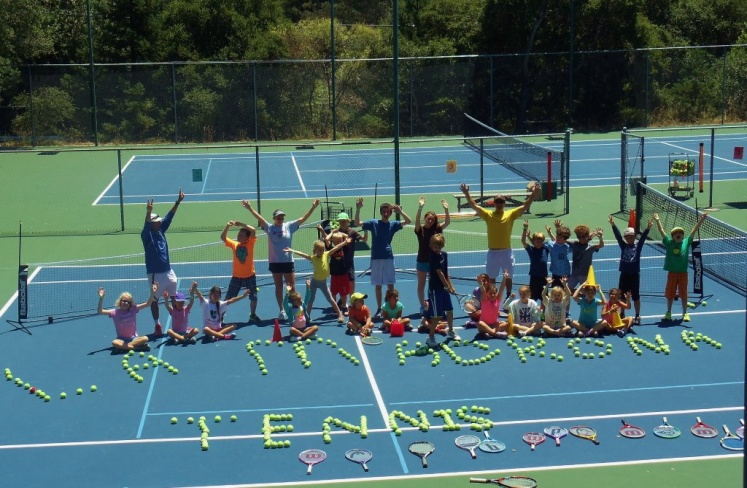
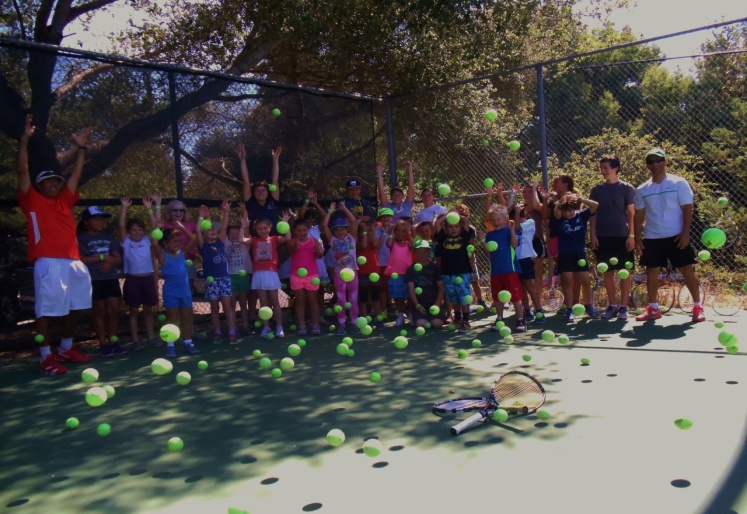
2014 Annual Junior Tennis Championships
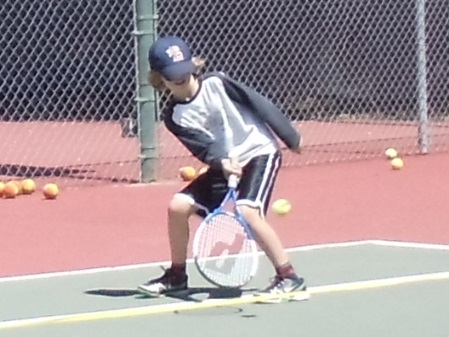 August 16-17, 2014
August 16-17, 2014
This is our annual junior event where our students show their skills and their passion for competitive tennis and an opportunity for some to play their first match ever here in our courts.
Events may be added or combined depending on the number of entries.
Singles will be played on Saturday 8/16 and doubles will be played on Sunday 8/17.
All matches will begin at 12:00 noon or later.
Divisions:
Red ball: Utilizing up to twelve 36’ courts, special balls and serves from the service line, young players with little experience may compete for their first time. Parents invited to assist in the matches as game organizers
Novice: Will be played on a 60’or full tennis court. This division is for juniors who have played practice sets and interclub matches. Orange ball, “green dot” ball or official ball may be used according to the level and age of the participant.
Challenger: For players with some tournament or high school tennis experience. Official ball will be used.
Awards to winners and finalists.
Special Prizes for sportsmanship, best attire and first time players in a tournament.
Snacks and Refreshments for players and spectators!
Lane’s Letter
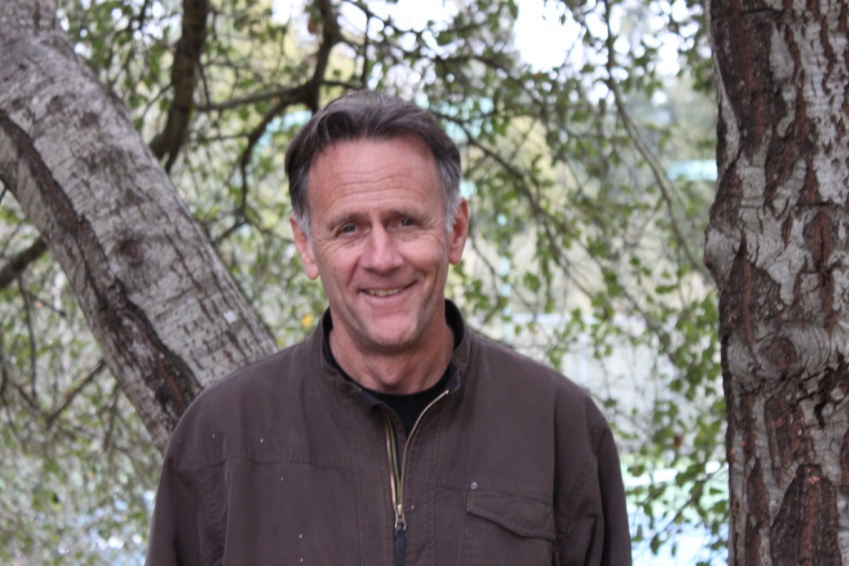 If you can't get to a sunset, at least make it to La Madrona!
If you can't get to a sunset, at least make it to La Madrona!
The surprises, the reassurance, the inspiration, the pleasure, the restoration of spirit that a beautiful sunset (or sunrise) affords us is one of those constants in life. Maybe we don't even know why, but at some level, in some way, we count on it.
The motivation behind what choices we make here with the environment we create derives from that inspiration. One of the advantages of spending the last 35 years with the plants, soils, rocks, waters, and countless sunrises is witnessing the unhurried nature of nature. It is the gravity tugging on us as our lives move ever faster influencing our perspective. Looking at the redwoods at the bottom of the pool area stairs and remembering back to planting them as two foot high seedlings then imagining them full grown a thousand years from now.
Not as grand as a sunset, but very grand.
Zumba: Sure its fun, but is it effective?
The Study
Led by Porcari and Mary Luettgen, M.S., researchers from the University’s Department of Exercise and Sport Science set out to determine the average exercise intensi¬ty and energy expenditure during a typical Zumba fitness class. First they recruited 19 healthy female volunteers, ages 18 to 22, all of whom had previous experience par¬ticipating in Zumba classes.
To establish a baseline of fitness for the study subjects, each performed a maximal treadmill test that measured heart rate (HR) and oxygen consumption V•O2. This test also enabled researchers to develop individual linear regression equations for each subject to predict their V•O2 based on HR readings. This was key because standard metabolic testing gear is bulky and wearing it would encumber the subjects’ ability to dance and properly participate in the Zumba class.
After the treadmill testing, each subject participated in a single Zumba session while equipped with a heart-rate monitor. While the class length varied from 32 to 52 min-utes depending on which day it was conducted, the same Zumba-certified instructor taught all of the sessions.
The Results
After crunching the resulting data, researchers found that participating in a single Zumba fitness class burned an aver¬age of 369 calories or about 9.5 kcal per minute.
The average HR was 154 beats per minute (bpm), which is roughly 80 percent of the average predicted HRmax for the subjects. Accepted fitness industry guidelines sug¬gest exercising in the range of 64 percent to 94 percent of HRmax to improve cardio endurance, so Zumba meets those requirements.
“If we look at the heart-rate monitor strips from the Zumba session, they kind of look like interval workouts, going back and forth between high intensity and low intensity,” says lead researcher Mary Luettgen, M.S. “Because of that, with Zumba you burn a lot of extra calories compared to a steady-state exercise like jogging.”
As for the average estimated percentage of V•O2max, the subjects averaged 64 percent of V•O2max, which is well within industry recommendations of 40 percent to 85 percent of V• O2max for improving cardio endurance.
Of particular note is that HRmax and V•O2max responses for all of the subjects fell within the range of industry guidelines, despite the fact that there was a wide range of fitness levels among the subjects.
The Bottom Line
Zumba may feel like a party, but this research suggests that it’s also a highly effective workout. “It’s a total-body exercise—a good, high-energy aerobic workout,” explains Dr. Porcari. “Zumba is also good for core strengthening and flexibility gains because there are lots of hip and midsection movements.”
With subjects burning an average of 369 calories per class, Zumba is also a fine choice for those who are look¬ing to drop a few pounds or maintain their current weight levels. In comparison with other exercises tested in the past by the University’s Department of Exercise and Sport Sci¬ence, Zumba burns more calories than cardio kickboxing, step aerobics, hooping and power yoga.
“The surprising thing is that it doesn’t matter what fitness level you’re at—our research shows that with Zumba every¬one is working out at the zone that’s recommended for im¬proving cardio health,” says Luettgen. “Both fit people and less-fit people are going to get an equally good workout.”
Bottom line, Zumba is an effective interval-style, full-body workout with built-in variety because every class and every instructor is slightly different. Equally important is the notion that Zumba is entertaining, which means exercisers are busy burning calories and getting fit while enjoying the fun of Latin dancing. Sounds like our kind of party.
ACE recommends that, before engaging in any exercise regimen for the first time, individuals consult with their doctors. This study was funded solely by a grant from the American Council on Exercise (ACE)
Reprinted from the American Council on Exercise.
Membership Upgrade Fee Change
Starting September 1st we will start charging membership upgrade fees for those wanting to add people to their membership. Members will need to pay the difference in the initiation fee for the level of upgrade. Please feel free to call the Clubhouse with any questions.
July 4th Bash!!!
Summertime was in full swing at La Madrona this past month for our annual July 4th Summer Bash! Members enjoyed a great summer day up at the pool with a BBQ, ping-pong tournament, shaved iced cones, and various pool related games. Thanks to everyone who came out to celebrate our independence while having fun in the sun!
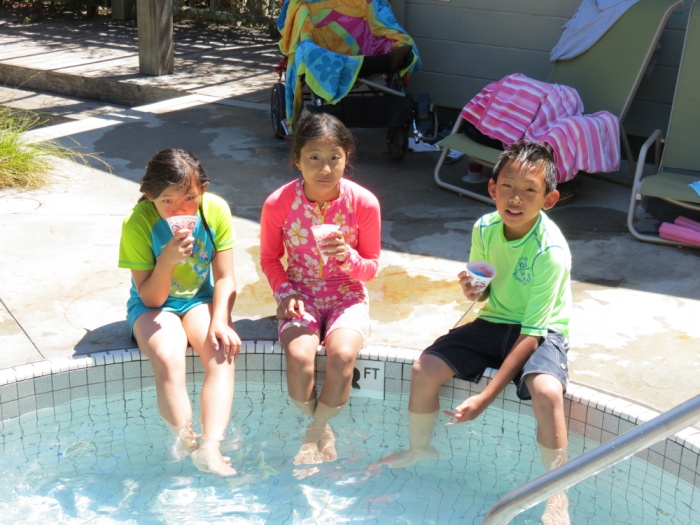
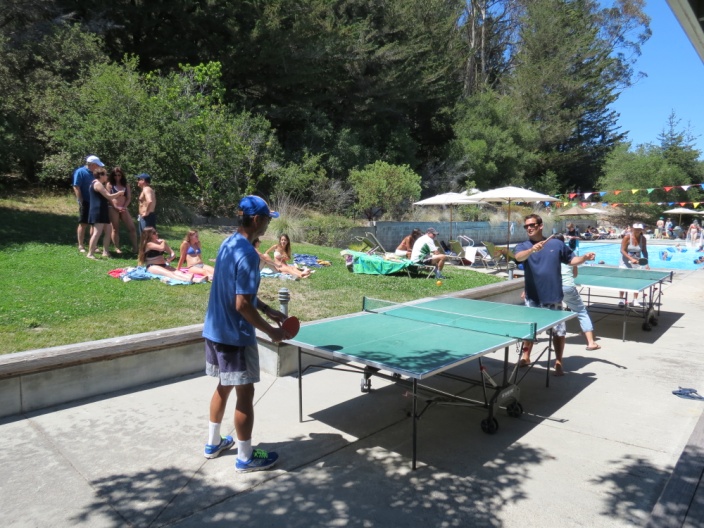
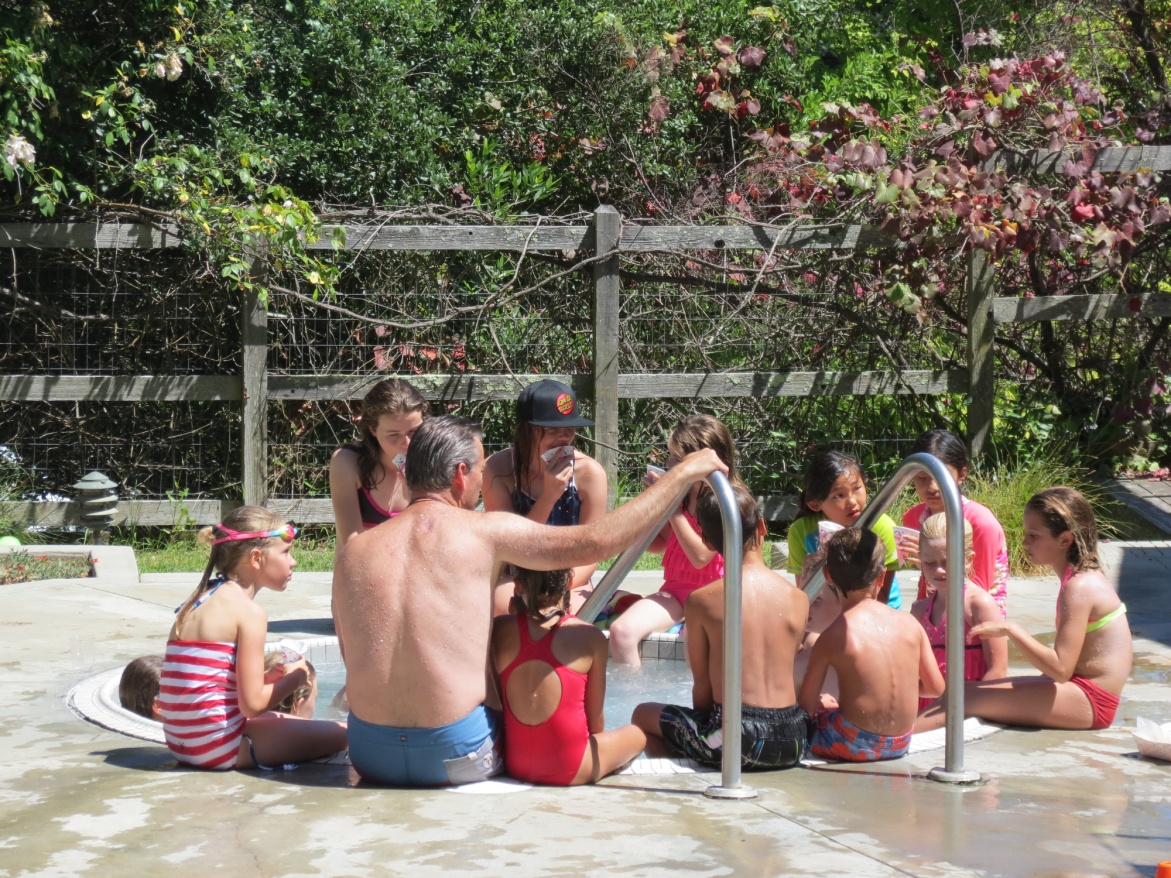
July First Friday Fitness Challenge Winner!
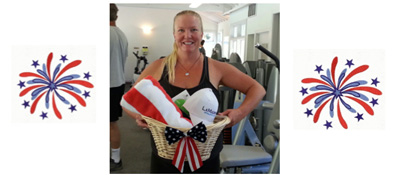 Debbie Sek
Debbie Sek
Congratulations to member Debbie for her first place win with 53 points!
Great job to our runners up!
Monica Terrazas (17 pts)
Ben Love (17 pts)

